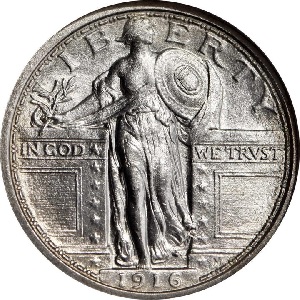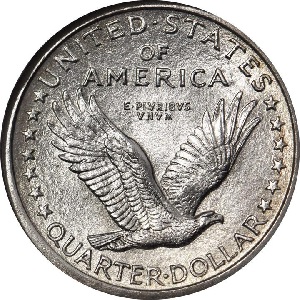1916 Standing Liberty Quarter
The year 1916 welcomed the appearance of a new dime, quarter, and half dollar. This marked the culmination of the "Renaissance of American Coinage" started in 1905 by then-president Theodore Roosevelt.(1)(2)
The quarter featured the work of Hermon A. MacNeil, depicting Miss Liberty standing between two revetments, hence the name of the coin, Standing Liberty quarter. Liberty also holds a shield, symbolizing national defense and an olive branch of peace, in response to the Great War engulfing Europe at the time.
The consensus view among collectors is that the Standing Liberty quarter rates among the most beautiful coins in United States history.(3)
Some controversy arose upon the release of the Standing Liberty quarter, when people noticed Liberty’s unclothed bosom. In mid-year 1917, Liberty was covered in a protective suit of armor. It was assumed for decades this was a reaction to the public outcry over nudity, but evidence has emerged suggesting the alteration was made as yet another signal to the world’s warring powers America was prepared for war, if necessary.(4)
It wasn’t until December 1916 when the Philadelphia Mint began striking the Standing Liberty quarter. Production was limited to only 52,000 pieces, one of the smallest mintages of a regular issue coin from the 20th century.(5)
The Mint held onto these until mid-January, when they were released along with much larger numbers of freshly struck 1917 quarters. There were no announcements beforehand of a new quarter design, so nearly the entire population of 1916 Standing Liberty quarters quietly melded into commerce.
Every Standing Liberty quarter is either Type 1 or Type 2. The first type was issued in 1916 and early 1917 and is characterized primarily by Liberty’s unclothed top and no stars below the reverse eagle. Type 2 has the attire addition and stars below eagle and was issued 1917-1930.
Fascinating Fact: The Standing Liberty quarter is notorious for wear on the date, usually vanishing within 10-15 years of circulation (this problem was rectified in 1925). Nevertheless, even on dateless Type 1 coins, 1916 examples are distinguishable from the 1917 due to subtle die differences.(6)
Although the 1916 Standing Liberty quarter is not ultra-rare, the old blue Whitman coin collecting albums used a cardboard insert in its place, acknowledging the challenge of acquiring an example of the date. Not much has changed since then.
Despite negative pricing trends in recent years, the 1916 Standing Liberty quarter will forever remain a Classic Rarity in American numismatics.
| Estimated survivors in all grades: 10,750 ?
The survivor estimate from PCGS represents an average of one or more experts' opinions as to how many examples survive of a particular coin in all grades. Survival estimates include coins that are raw, certified by PCGS, and certified by other grading services. Learn more at PCGS. |
| PCGS Rarity Scale: 2.9 ?
The 'PCGS CoinFacts Rarity Scale' assesses the relative rarity of all U.S. coins, based on estimated surviving examples. The scale runs from 1.0 to 10.0. The higher the number, the rarer the coin.
Learn more at PCGS. |
| Click HERE to check for availability on eBay** |
Preview of eBay selection:
 |
 |
| Trendline Avg = 9.83 | CLASSIC RARITY |
Historic Value Trend Charts:
| Last updated 4-8-25 | Return to Key Date Coin List | |
| Compare to Common Date Coin of Same Type | ||
|
|
||
| Download Charts to Your Computer | ||
Sources
1. Stack's Bowers Galleries. 1916 Standing Liberty Quarter. May 2019 Auction.
2. Garrett, Jeff and Guth, Ron. 100 Greatest U.S. Coins, 5th ed. Pelham, AL: Whitman Publishing, 2019.
3. Stack's Bowers Galleries. 1916 Standing Liberty Quarter. May 2019 Auction.
4. Garrett, Jeff and Guth, Ron. 100 Greatest U.S. Coins, 5th ed. Pelham, AL: Whitman Publishing, 2019.
5. Stack's Bowers Galleries. 1916 Standing Liberty Quarter. Aug 2012 Auction.
6. NGC. 1916 STANDING 25C MS.
**Many very fine coin dealers sell on eBay. At any point in time, there may be over one million search results for United States coins. This includes quite a few of the recommendations on our Key Date Coin List.
If you’re thinking about purchasing a rare coin, eBay is certainly worth a look. For your convenience, the links from this site to eBay are coded to bring up only coins certified by PCGS and NGC.
As is always, always the case, never buy a valuable coin from a seller whose trustworthiness cannot be verified. Learn more about this at our chapter Best Places to Buy Coins, which also has a section on doing business on eBay.
In the interest of full disclosure, Rare Coins 101 receives a small commission anytime someone connects to eBay from this site and purchases something.
Coin Images by Stack's Bowers Galleries.


